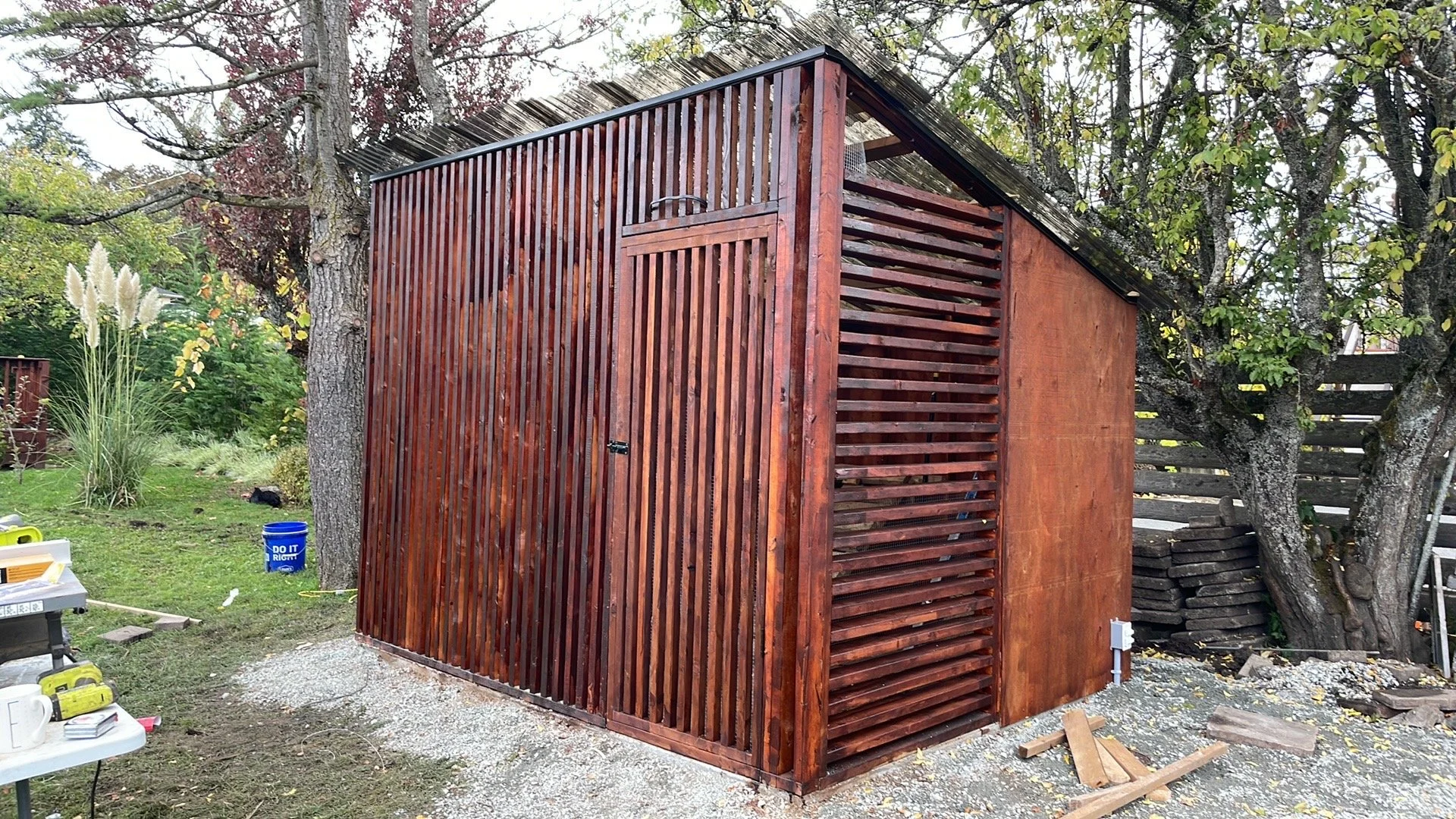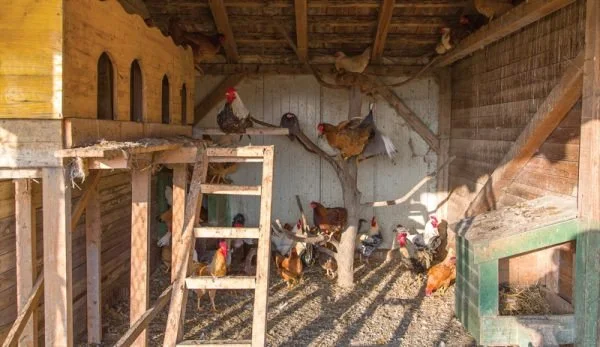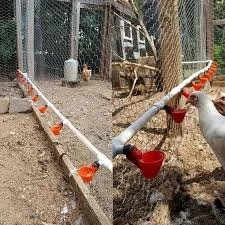The Hen House
Exploring usability and empathy in a chicken coop project
As a UX designer and researcher, I thought there would be no better way to showcase my empathy for a user than to report my process for planning and building a new chicken coop for my three chickens, Francine, Charlene, and Edith. The insights I gathered during the process have undoubtably taught me the crucial need to view a product through the eyes of a user at all times, from start to finish.
My Role: Concept creator, designer, researcher, builder, and chicken husbandry technician :)
Project Duration: 3 weeks starting mid-October 2022
Problem: My three hens are egg producing chickens and were in need of a new coop after outgrowing their original one. They needed a coop that would protect them from the elements, predators, and pests, mainly rats.
They also need things that will make them healthy and happy like plenty of space to roam, natural light, ventilation, dynamic places to roost, toys, an ash bath, and automatic food and water feeders.
Solution: Build a larger coop that prevents the rain and pests from getting in, as well as other features that keep the chickens happy so they continue to lay eggs.
Challenges:
Foundational research: Determine what basic needs chickens have, as well as some extra features in order to keep them happy and laying eggs year round.
Costs: I could not afford to pay someone to build a new coop, so I needed to learn how to build one myself.
Design: Design a structure that acts as a chicken run as well as a coop with nesting boxes. Integrate research findings into designs to develop features that proliferate chicken health and happiness. Integrate human-based, time-saving ergonomics into my designs for easy access during cleaning, egg collection, and topping off feeders.
Problems:
The first chicken coop I owned was purchased from the store for $1000. Over the course of 2 years the wet winter weather and high winds on Vancouver Island badly damaged the coop. Predators and pest, mainly rats, also damaged the coop.
Coop issues:
Leaking roof
No protection from storming rain
Flooding foundation
Rats digging under the structure
Raccoons damaging the structure
No automatic feeders
Small space for chickens
Access limited for food refill and cleaning
Lack of natural sunlight
Secondary Research
Eggs: Researching online determined that egg laying volumes are closely linked to whether they are happy or not. Other factors include the time of year affecting the amount of natural light and if the chicks have access to that light. Diet is also a factor, with higher mineral and protein feeds yielding more eggs laid and better shell integrity.
Boredom: Chickens need things to do otherwise they might start pecking at each other. They enjoy shiny things, toys, and places to climb and roost.
Airflow and structure: Proper venting is extremely important year round. Chickens need the proper airflow and shade to escape the heat in the summer. In the winter the chickens need proper venting in their nesting boxes to prevent condensation and moisture building up. They depend on dry airflow in their feathers to trap air against their bodies and stay warm much like a down jacket.
Predation and pests: The structure of the coop needs to be solid with no gaps to prevent predators and pests from getting in. After surveying information from multiple coop construction and husbandry websites, it was determined that a concrete slab and heavily-framed structure on top would be the best option. That way nothing can dig under to access the coop or get through the sides or roof.
Food and Water: Automatic feeders that distribute fresh and clean food and water is the optimal way to keep the chickens healthy and happy. It also saves me time and worry.
Audit
To get an idea of what successful coops look like, I conducted a non-competitive audit from online sources consisting of manufacturer sites and husbandry publications. I identified designs and came up with feature variations for structures, toys, and feeder systems.
Construction
Drainage and concrete pad
I started the project by renting a trencher and digging drainage lines near the coop. This would pull water away from the area and prevent the flooding a saw in the winter months. I used 4-inch diameter perforated pipe and trenched it to the nearby river. I also elevated the coop area by building a road-base rock pad and another 4-inch thick concrete pad on top.
Framing
I used 12 and 8-foot, 2’’x4’’ SPF to frame up the sides of the coop, making a 12-feet by 8-feet structure. This saved me time because 2x4s come precut at those lengths. I laid them out in the spindle formation that I gathered from one of the designs in the audit. The design has a nice modern look to it and also acts as excellent protection from predators. The design also adds plenty of shade to the insides of this south-facing structure.
I also trenched in an electrical line from a box near my hot tub. The line will eventually electrify the coop for plugs, lights, and a Ring System Camera.
It started to rain so I had to improvise and build a shelter as I was sheathing around the backside of the coop and building the nesting boxes. The chicks love the rain :)
Once I added the plywood around the backside, the whole coop was solid. Dynamite! I was worried about the spindled walls lacking in shear strength, but the plywood made it square and solid.
Stain
Next, I sprayed the whole thing with a stain that matches the others structures in the yard. I added two generous coats. There were a few runs in the stain, but I was more concerned about getting the thing sealed before the heavy winter rains because some of the wood was not treated due to cost savings.
Inside the Coop
Next I added the roof, which was a super strong light-weight polycarbonate material. I used screws with rubber waterproofing gaskets to fasten them to roof rafters. I wont be walking on the roof, so I did not use metal bracing brackets. The poly laid down good and tight.
I also added 1/4 inch metal grating to all gaps in the coop. This will prevent rats and mice from getting into the coop.
Next, I built the internal structures, which included the nesting boxes, shelving, roosting racks, and an ash bath. I decided on these features by using the research I did earlier and gathered inspiration from the designs and features noted in the audit. I left plenty of room between the framing of the nesting boxes and the roof to ensure proper ventilation.
For the bath I framed in a 4 -foot by 2-foot structure elevated from the floor and found ash from my fireplace and from the store. I also added some black dirt from where I see the birds bathing in the summer.
I went to the dollar store and found some fun toys and small mirrors to hang for the chicks. I also built a swing.
I made a grub piñata with a snow globe toy and emptying out the contents (no liquid in it). Then I dried holes in it and filled it with grubs. Later I hung it where the birds could reach.
Sand and wood shavings were added to the floor of the coop to insulate their feet from the concrete and cold.
I built the roosting rack on the opposite side of the nesting coop using ripped (cut in half down the length) 2x4s. I made three tiers and hung toys at different levels.
Systems
The final elements to add were the feeder and water systems. I discovered some designs through the research and audit portion of my project. I chose to use 50-gallon food-grade barrels for both systems.
The feeder system was very simple. I cut 4-inch diameter holes at the base of the barrel, and then placed 4-inch diameter plastic plumbing elbows. This will allow the feed to be gravity-fed as the chickens eat it. I filled the barrels with feed. This should last the chickens at least a six months, especially with no rodents pilfering it. The barrel was placed in the coop where the chicks could access it.
The water system was more complex. The barrel was placed outside to allow more room for the birds. I put a valve at the base of the barrel and sealed it with a gasket and silicone. Then I connected PVC piping from the barrel to a spring fed cup feeders inside. The gravity of the water weighs down the cup and stops the flow. As the chickens drink the water, the weight decreases and opens the valve, distributing the water and closing the flow once it is filled. 50-gallons of water will last the birds at least six months or more.
Both systems will ensure the birds are getting clean, fresh food and water, which will have tremendous influence on their egg laying and overall health.
I also added electricity to the coop and installed plugs, lights, and a camera. The additions make it convenient for working outside in the dark and checking on the chicks at night. The camera is excellent for monitoring the birds and watching for predators and pests.
Usability Study
Methods: Due to communication limitations with the birds, I designed the study with measurements based on egg laying and the bird’s use of the features. Based on behavioral findings from secondary research, egg laying and use of the features, such as the toys, piñata feeder, and dust bath, indicates the birds are healthy and happy.
I collected data for 6 weeks using the measurements below.
I also observed the chickens on the camera and noted their behavior.
Number of eggs laid in nesting boxes: Egg laying was determined in the research to indicate healthy, happy bird behavior.
KPI: Success Rates: Number of eggs in the nesting boxes, 3 a day would mean each bird laid one egg. They average one egg a day, but factors like light, time of year, diet and health can influence egg laying.
Bathing: This is a behavior observed in healthy birds. Chickens will instinctively find dust to fluff up and nestle into. It’s part of how they stay clean and rid themselves of pests like mites. Average frequency in bathing is once every 2-3 days.
KPI: Success Rate: Chicken bathing was measured by body impressions in the ash bath. The ash bath was raked each week to reset the area for new impressions.
Grub consumption: The piñata was hung from the lower level of the roosting rack. The more the chickens pecked the piñata, the more grubs fell out. The behavior shows the chickens are engaging with the toys, though in a feeding capacity. However, it demonstrates they are spending more time playing with the toys and less time pecking at each other.
KPI: Success Rate: Grubs gone from the piñata.
Camera Observations: Observing active behaviors that indicate healthy, happy birds: grooming, foraging, playing with other toys.
KPI: Behavior occurred or not occur. Behaviors included, playing with toys, using the bath, pecking the piñata, and climbing the roosting rack.
Eggs just taken from the coop after being away for a week.
Findings and Discussion
Since the chickens were already living in the new coop at the time of the study I was unable to develop a baseline measurement for comparison. Therefore, the findings are limited to whether the chickens are using the features and if they are exhibiting happy behavior as determined by them laying eggs and displaying “happy” behavior.
Eggs:
Secondary research indicated that the average number of eggs laid by my particular heritage breed during the winter months is 2-6 per bird per week.
My three birds were laying much more than the average at close to one egg per day. The two younger birds produce pink eggs and the older bird, Francine, produces blue eggs. I noticed there were fewer blue eggs per week. Still, Francine, and the other birds were producing higher than average.
Bath:
Secondary research revealed that most chickens take dust baths every 2-3 days. Over the 6 weeks of observations, body impressions in the ash in the bath showed mixed findings. There were impressions in the bath, but the observation period was too broad to determine if the birds were bathing every two days. However, the findings from depressions do show that at least one bird was bathing. Observations from the camera reveal that all three birds were bathing, though during cooler temperatures they were not bathing at all.
Grubs: The clear plastic piñata globe was checked at the end of each week. Consumption volumes were measured in 1/4 increments with 1 indicating all grubs were eaten. Findings showed that the birds were pecking the globe enough to fully empty the container. Camera footage shows most the interaction in the afternoons. Lower volumes consumed at the first two weeks might indicate a learning and acclimation period.
Fig. 1 Eggs in coop vs Time. Fig. 2 Grubs Consumed vs Time Fig. 3 Bath impressions made by birds vs Time
Insights and Takeaways
The number of eggs observed over 6 weeks was enough to indicate a healthy, happy living situation. Despite running the study during the winter months, which offer lower light and colder temperatures, the birds continued to lay. The introduction of the grubs (protein) in their diet might have an added influence on laying considering that typical feeds designed for laying birds are made with higher protein and mineral content. The main chicken feed and volume during the study was not altered.
Bath impressions and camera footage reveal the birds are using the ash bath, though there is variation or no use at all during colder temperatures. Multiple birds have been seen in the bath at the same time, indicating the size (4 feet by 2 feet) of the bath is adequate.
The birds frequently use the grub piñata and are able to peck at it and access the grubs. The piñata was hung on the first tier of the roosting rack and the birds access it from the floor. Based on the findings, the design and location seem satisfactory for accessibility.
Upon inspection, the coop meets my own expectations for protection from rain, predators, and pests. There appears to be proper ventilation in the nesting boxes and no condensation. Bird tracks around the floor space and camera footage also indicate the birds are using the entirety of the coop and getting proper exercise.
Iterations
A back-up water source: Vancouver Island has a climate that presents freezing conditions in the winter. The 50-gallon barrel froze at one point, and the PBC waterline froze which caused a piston of ice to blast from the end. Luckily the end cap was not glued on and it merely popped off. Solution: Add an electric thermal cord down the length of the waterline to prevent it from freezing. Also add a back up five-gallon bucket with metal nipple droppers. Add ping-pong balls inside the bucket and the 50-gallon barrel to help prevent ice crystals from forming.
Piñata runs empty: The piñata is a popular toy. On occasions when I am away, the chicks empty the grubs in a few days. Solution: One consideration could be to make the piñata with smaller holes so that fewer grubs fall per peck, thus extending time per filling. Or, the addition of more piñatas in tough to reach places on the roosting rack might be considered. That way the birds might consume the grubs slower, and they would also utilize other areas of the coop. A wild notion might be to add a Furbo or automatic treat dispenser.
Roosting Rack Access: The birds are not drawn to the higher areas on the roosting rack. Camera footage reveals they have not been observed on the second or top tier. This could be because there is no ladder like the one to the nesting boxes. Solution: The birds are clearly drawn to the grub piñata. Adding more piñatas to higher places on the roosting racks could lure them higher on the rack.
Let’s Connect
Thank you so much for checking out my case study!
Do you have questions or comments? I’d like to hear from you.
Contact me at editor@shaneharms.com or sharms206@gmail.com.




































